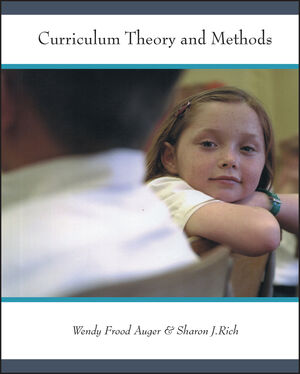|
Textbook
Curriculum Theory and Methods: Perspectives on Learning and TeachingISBN: 978-0-470-83774-0
Hardcover
424 pages
September 2006, ©2007
 |
||||||
Chapter 1: LEARNING & TEACHING: Charting the
Course
The Shift from Behaviourism to Cognitivism to
Constructivism
Cognitive Development
Off to School
The Importance of Experience in Cognitive
Development
Key Aspects of Cognitive Development
Major Theorists
John Dewey
Jean Piaget
Piaget's Stages of Cognitive Development
Social Cognition And Social Constructivism
Lev Vygotsky
The Theory Of Multiple Intelligences
Howard Gardner
Emotional Development
Daniel Goleman
Physical Development
Physical Development in Younger Children
Physical Development in the Primary Grades
Physical Development in the Junior and Intermediate
Grades
Summary
Chapter 2: CONSTRUCTIVISM: Making Connections, Risk-Taking, and
Other Sundry Bits
What is Constructivism?
Bruner Thinks About Thinking
How Children Construct Knowledge
Educating the Whole Child
Examining the 3 Cs: A Rationale for Teaching the Whole
Child
Incorporating Students' Interests into Learning
The Reggio Emilia Approach
Setting the Stage for Using Prediction: Adaptation
Revisited
Adaptation in Action: The Prediction Learning Cycle
Summary of How the Prediction Learning Process
Works
The Importance of Risk-taking
The Serious Business Of Play
Key Characteristics of Play
Play: Is It a Valuable and Viable Part of
Learning?
How Children Use Play
Play and Older Students
Piaget's Stages Revisited
Organizing the Constructivist Classroom and the Role of the Teacher
in Constructivism
Summary
Chapter 3: AUTONOMY: A Self-Starter is Born
Invitational Learning
Autonomy
Moral Autonomy ("Free will")
Intellectual Autonomy ("Free choice")
Practical Applications of Autonomous Teaching
Autonomy and Play
Self-Concept & Self-Esteem
Self-Esteem
Creating An Atmosphere For Learning
Summary
Chapter 4:
THE BRAIN IN A PLAIN BROWN WRAPPER:
Everything You Ever Wanted to Know About the Brain and Might Be
Afraid to Ask
The Human Brain
Key Brain Structures
How a Message is Transmitted
Brain Development in Young Children
The Role of Activity in Brain Growth and
Development
If You Don't Use It, You'll Lose It
Novelty, Laughter, & Learning
"Food" for Thought
Hemispheric Specialization
How the Hemispheres of the Brain Work
Adaptability and Flexibility
Important Considerations for Learning
Cognitive Theory and the Human Brain
Learning Is an Active Process
Learning Is Non-linear
Learning Is Multi-dimensional
Learning Is Set Within a Social Context
Learning Is Influenced by the Affective Domain
Learning Is Concerned with Cognition and
Metacognition
Attention and the Brain
Summary: Developing the Brain-Compatible Classroom
Part II CREATING THE ROAD MAP FOR TEACHING & LEARNING
Chapter 5: PLANNING: The Itinerary
Getting Started: The "How People Learn" Framework
Knowledge
Students
Communities
Evidence
Planning to Account for Knowledge, Student, Community, and
Evidence
Getting Started
Theme Planning
Planning for Centres: Is It Necessary?
Professional Planning
Summary
Chapter 6: STARTING WITH WHAT YOU HAVE: Organizing Time, Space,
and Materials
Starting with the School: Design Principles
So What? Classroom Design
Primary and Upper Elementary Classroom Organization: The
Same or Different
Matching Classroom Design and Teaching
Philosophy
Classroom Decoration? Yours, Mine, and Ours
Storage: Things to Think About
What Will You Do All Day? Thinking Through the
Timetable
Biological Issues
Subject and Division Issues
Organizing Units
Daily Schedules
Time Management
Managing Resources
Centres in the Classroom
Summary
Chapter 7: STRATEGIES FOR TEACHING: The Teacher's Tool
Kit
Teaching Strategies
Personal Attitude and Management Skills
Classroom Management
Questioning Skills
Organization Strategies
Cooperative Learning
The Integrated Day Approach
Rationale for Using the Integrated Day
Plan Sheets: A Method of Planning, Implementing, Adjusting,
and Tracking in the Integrated Day
Benefits of the Integrated Day Approach
Summary
Chapter 8: THE CURRICULUM: Organizing Pieces of the
Puzzle
Views of Curriculum
Curriculum: A Contested Arena
Curriculum Control in Canada
Curriculum Development and Implementation
Curriculum Mapping for the Classroom Teacher
Subject Matter: Does It Matter? (Or should there be
content-free curriculum)
A Current Curriculum Issue: Does One Size Fit
All?
Student Engagement and Alternative Curriculum
Approaches
Problem- or Project-based Learning
Integration Across the Curriculum
Curriculum Orientation
Summary
Chapter 9: ASSESSMENT AND EVALUATION: The Glass is Half
Full
Assessment: The Context of Public Accountability
Principles of Authentic Accountability
Testing, Testing, and More Testing: Children, Tests, and
Teacher Expectations
Evaluation and Assessment: The Same or
Different?
Authentic Assessment: What Is It?
Strategies for Assessment
Data, Data, and More Data: Answering the "So What?"
Question
Teacher Performance Appraisals
Summary
Part III ENHANCING CHILDREN'S THINKING
Chapter 10: ADJUSTING THE PROGRAM: One Size Does Not Fit
All
What is Diversity?
Cultural and Linguistic Diversity
Maintaining and Fostering Socio-cultural
Awareness
Multiliteracy Pedagogy: An Overview
Valuing Cultural and Linguistic Diversity
Another Form of Diversity: The Special Needs
Student
Inclusive Pedagogy
Diversity, Engagement, and Student Achievement
Summary
Chapter 11: ENRICHMENT: Letting the Genie Out of the
Bottle
The Process of Thinking
Creative Thinking
Creativity and the Arts
How Teachers Can Foster Creativity
Critical Thinking
Problem Solving
Encouraging Thinking & Promoting Metacognition
How Teachers Can Facilitate Metacognition
The Importance of Thinking Skills
Thinking Skills Revisits Questioning
Graphic Organizers
Mind Mapping
Making Connections
Summary
Part IV LOOKING AT THE BIG PICTURE
Chapter 12: ESTABLISHING BALANCE: Putting It Together
Begin at the Beginning: What Makes a Good Teacher
Becoming a Co-Learner: Assuming a Critically Reflective
Stance
A Learning Community: What Is It?
Action Research as a Means to Understand
Teaching
Parents, Teachers, and Schools: Partners?
Getting to Know Parents: What to Do?
Preparing to Meet Parents: First Impressions
Matter
Understanding Performance Appraisal: Teacher Evaluation
Self Evaluation
The Creation of the Context for Sharing: No More
Boundaries
Summary: Finding Balance-Taking Care of the Self
Chapter 13: CLOSING THOUGHTS: "This Way to the
Egress!"
Alphabet Soup… The 3 Rs
What is Effective Teaching?
Professional Learning Communities
Learning with Colleagues
Benefits of Participation in a Professional Learning
Community
Moral Development
Character Education
The Only Constant is Change
Educational Reform and Leadership
Initiatives in Teacher Education
The ABC's of Beginning Teaching
Final Inspirational Thoughts: A Credo for
Children
Summary



